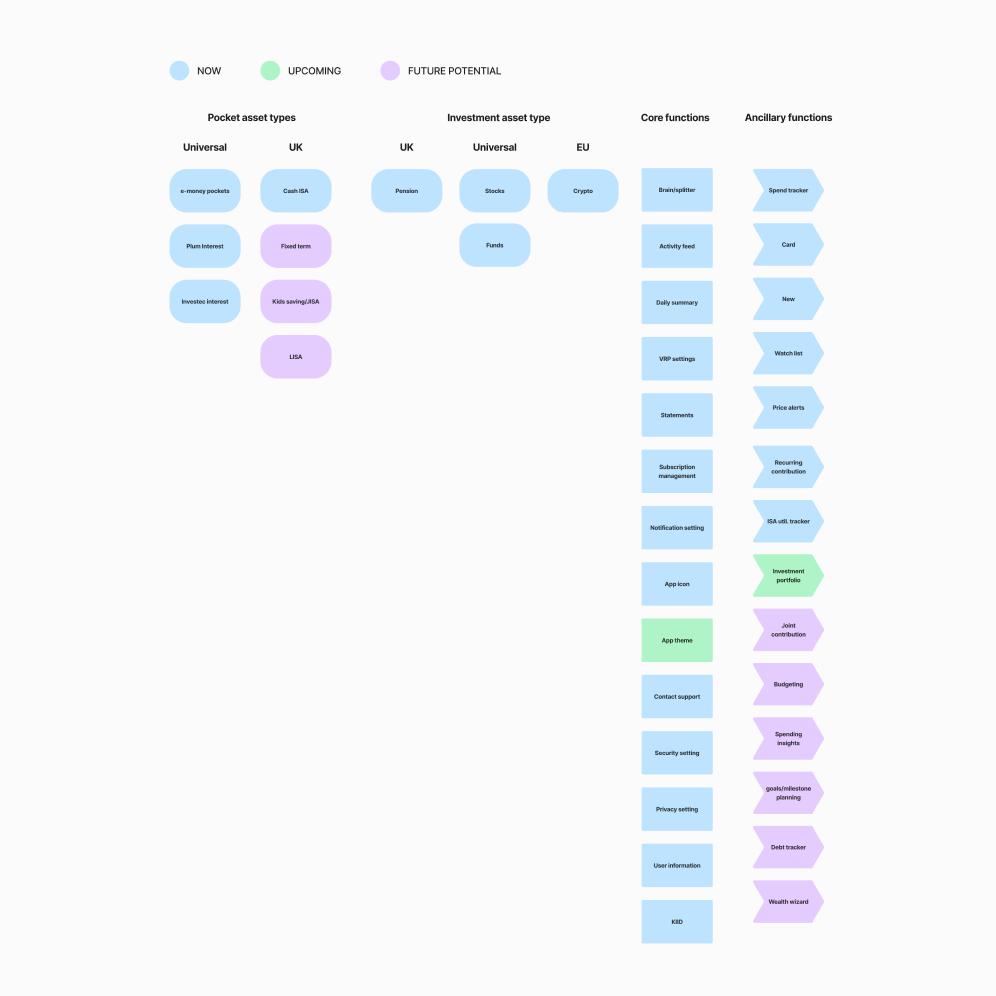QMMF & Cash ISA
Provide a high interest savings product to entice new customers to adopt Plum ecosystem
Project Impact
80% New User Deposit Rate
£100M Net Deposits after first the first month
Project Background
As interest rate have remained high, Plum wanted to offer savings products with highest possible interest rates in order to draw new customers into the Plum ecosystem. Once activated, those customers can then enter the cross-sell or upsell funnels to become paid customers.
Approach and Process
Depending on the confidence level in the project, different types of flow maps might be used to sketch out the overall experience. The flow maps then would be reviewed by key stakeholders to assess business viability and technical feasibility.
Confidence: Low
When approaching user flows with low confidence, a flow map is created to outline key user or system touch points to help the team assess the project to identify any technical challenges/requirements as well as any other requirements from other teams.
An example of this is the the transfer-out process for the Cash ISA account, as this interaction has not existed in the Plum ecosystem before, this method has help the team work out the tech design prior to any efforts committed to higher fidelity work.
Confidence: Medium
When approaching user flows with medium confidence, a flow map with screen flow is created to work out how specific important business logic or backend states is communicated to the user.
An example of this is the QMMF withdrawal timelines where a different withdrawal time is applied depending on the amount the user is withdrawing. This approach helped to visualise the complex flows and logic in presenting to stakeholders as well as the wider team.
Confidence: High
When approaching user flows with high confidence, screen flow is created straight away to ensure a fast delivery.
The examples here are the KYC flows, deposit flows, and general navigation flows. By skipping the typical wireframe or low fidelity designs, designs can be delivered with agility by utilising an established design system and templates, in which many recurring design decisions has already been solved.
App Information Architecture
Define new IA that which re-organises all existing features in a way that allows the product to scale.
Project Background
Plum as a product has gone through many stages of change, as it responds to the changes in the market, whether it be joining the trend of offering cryptocurrency during the cryptocurrency hype, or offering stocks during the GameStop hype. As a result, the app has become a hodgepodge of various capabilities, without any underlying experience that connects everything together. And this problem is reflected in some of Plum’s most common customer feedback, being that the app is too confusing.
Primary Research
By interviewing 12 high frequency app users and conducting closed card sorting exercise I was able to identify key items our users expect to see, prioritised in order of importance and relevance.
IA Design Process
A full feature audit was conducted to produce a categoric view of all asset types, core functions, and ancillary functions.
IA Validation
All listed features was then organised under new titles that represented the new navigation tab for the app.
Tree test was then conducted to ensure the new organisation make sense for our users, and the new IA does not impede features that drive key business metrics: asset discovery, asset access, and asset updates.
0 to 1 Design System
Design and implement a new design system which enables agility, efficiency, and quality.
Project Background
Plum as an organisation has undergone several iterations of tooling and tech migrations over the past 3 years. Doing any type of migration can become chaotic, especially when there are time sensitive business objectives. As a result, Plum’s design system has been left by the wayside, which in turn became the root of the plethora of operational inefficiencies within the design and engineering departments.
Design system Discovery
As a design systems is a product that serves a product, the approach must mirror that of which is used for any customer facing features.
Cross discipline workshop between design, engineer, and product was conducted to establish empathy between disciplines, share business goals, technical decisions, and design principles.
Design System Documentation
Achieved single source of truth by building a case to adopt Supernova, a design system management platform.
In addition, a design process was put in place to ensure parity between production design system and code.
Atomic Design Principles
Principles of Atomic Design is applied throughout the design system to ensure scalability and robustness. In addition, an identical naming convention is applied to the Figma design and developer code base allowed the teams to speak the same language, and massively improving design system related communication.
Design Impact
The new design system enabled every team to make app wide improvements, updating designs that haven been stuck for years, and addressing every pattern inconsistency.
While it’s still too early to accurately evaluate, we have a conservative initial estimate of which the design system will reduce design and development time by 20% which equates to £250,000/year in operational costs. The typical industry benchmark for the ROI of a working design system is somewhere between 35%-50%.














